Invisalign® in Enfield, CT
Straighten Teeth with Clear Braces
Do you have crooked teeth? Misaligned pearly whites can put a damper on your confidence and may even jeopardize your oral health. Fortunately, there are multiple orthodontic treatments that have the power to straighten out your smile, thereby improving your appearance and perhaps even preventing tooth decay, chipped teeth, and other serious dental problems. Invisalign® in Enfield is a popular way to reposition teeth because of the many practical benefits it offers. Let’s take a moment to consider some key facts about these clear braces.
How Invisalign® Works
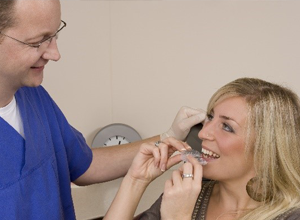 Your teeth can move slightly because they are attached to your jaw
via ligaments. Both traditional braces and Invisalign® take advantage of
your teeth's natural mobility to reposition them over time. With enough
gentle, sustained pressure, it is possible for your teeth to gradually move
into their proper places.
Your teeth can move slightly because they are attached to your jaw
via ligaments. Both traditional braces and Invisalign® take advantage of
your teeth's natural mobility to reposition them over time. With enough
gentle, sustained pressure, it is possible for your teeth to gradually move
into their proper places.
While the basic principle behind Invisalign® and metal braces is the same, there are differences in the way that treatment proceeds. For regular braces to do their job, your orthodontist has to tighten them periodically. With Invisalign®, your dentist in Enfield provides you with a set of clear thermoplastic aligners. You wear each aligner for 20 to 22 hours each day, and you switch to a new one about every two weeks. Regular dental visits are still important so a professional can keep an eye on your teeth’s progress.
Who Can Invisalign Help?

Invisalign is an excellent treatment choice for many cases of mild to moderate dental misalignment. When you visit our office for a consultation, our team will examine your mouth, learn a bit about your preferences and lifestyle, and then make a recommendation on whether Invisalign is a fit for you. Below, you will find some specific examples of orthodontic problems that Invisalign can often be used to address:
Crowded Teeth
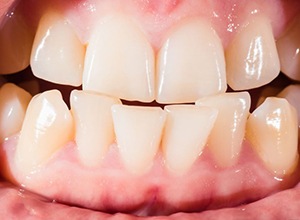
Crowded and overlapping teeth can easily catch food between them, increasing your risk of decay, gum disease, and bad breath. They can also hit one another at odd angles and be at a heightened risk of breakage. Fortunately, Invisalign is often able to shift the teeth in a way that allows each one to have the space it needs to function optimally.
Gaps Between Teeth
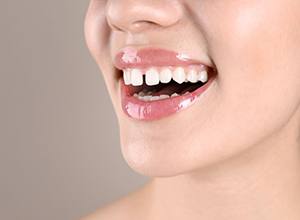
While gaps between the teeth might seem cute and quirky, they can actually spell trouble for your oral health! They can leave your gums vulnerable to irritation and harm. Invisalign may be able to move your teeth closer together, leading to improved oral health, clearer speech, and other benefits.
Overbite
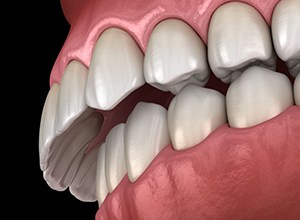
If your upper teeth rest too far in front of your bottom teeth, you have a type of malocclusion (bad bite) known as an overbite. This issue can affect your speech and place your teeth at a heightened risk of premature wear and tear. In many cases, Invisalign can work along with special accessories to correct an overbite.
Underbite
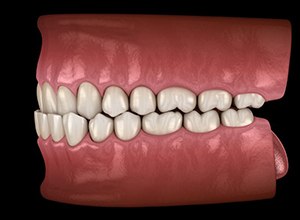
An underbite occurs when the lower teeth rest in front of the top teeth. If you have this problem, it might affect your facial profile, cause jaw pain, adversely affect your speech, and contribute to other issues. Invisalign can successfully treat some cases of underbite by shifting the teeth and training the lower jaw to rest in its proper position.
Crossbite
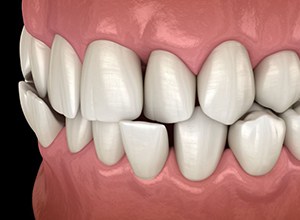
A crossbite is a type of malocclusion that happens when only some of the bottom teeth rest in front of the top teeth. It can interfere with speech, contribute to teeth grinding, and affect facial symmetry. Some cases of crossbite can be successfully corrected with Invisalign clear aligners and appropriate accessories.
Open Bite
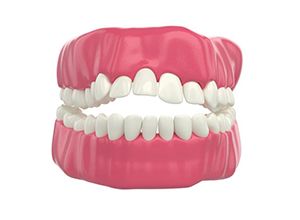
You may have an open bite if there is a vertical gap between your front top and bottom teeth, even when your back teeth are touching. An open bite can adversely affect your speech, interfere with your biting ability, and have negative consequences for your self-confidence. Invisalign aligners are often able to close an open bite.
The Benefits of Invisalign®
When you choose Invisalign® to straighten your teeth, you can expect some significant benefits:

- The aligners are clear. It is still possible for onlookers to spot them, but you will be able to maintain a professional appearance and avoid accusations of being a “metal mouth.”
- Traditional braces come with a laundry list of dietary restrictions, but Invisalign® does not have that issue. Because the aligners are removable, you can eat and drink pretty much anything.
- The average treatment time with Invisalign® is about 12 months, making it faster than traditional metal braces. You may start to notice a difference in the way your teeth look after just a couple of months.
- One of the big complaints that people have about metal braces is that the brackets and wires can irritate the gums and other soft tissues in the mouth. Many people have commented on how comfortable Invisalign® is.
- Invisalign® makes it easier to maintain a clean mouth since you do not have to navigate around a metal framework when you are brushing and flossing.
- Invisalign® is suitable for most cases of malocclusion (bad bite) and misalignment.
- Many insurance plans are willing to help cover the cost of Invisalign®.
Living with Invisalign Aligners
 Invisalign is an easy and convenient orthodontic treatment; you can expect to have minimal impact on your daily life.
However, it will still have some impact. You may need to learn some new habits and adjust some of your
usual customs in order to succeed with your aligners. Before you know it, though, living with Invisalign should be a
normal and effortless part of your routine! What specifically will you need to do to keep your treatment on track?
Continue reading below to find out.
Invisalign is an easy and convenient orthodontic treatment; you can expect to have minimal impact on your daily life.
However, it will still have some impact. You may need to learn some new habits and adjust some of your
usual customs in order to succeed with your aligners. Before you know it, though, living with Invisalign should be a
normal and effortless part of your routine! What specifically will you need to do to keep your treatment on track?
Continue reading below to find out.
Wearing Your Trays
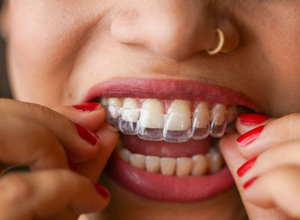
You should make an effort to wear your aligners for 20 – 22 hours each day. They only work when they are on your teeth, so failing to meet the recommended wear time could slow down your results. It might even make it difficult or impossible to wear future aligners in your series. As a general rule of thumb, you should only take your aligners out of your mouth when you are eating or drinking anything other than plain water.
Cleaning Your Aligners
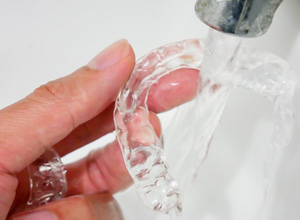
Keeping your aligners clean can prevent them from accumulating stains and odors. It also protects your oral health. You should rinse your aligners after each meal (be sure to use cool or lukewarm water — not hot). At least once a day, you should give them a more thorough cleaning. Brush all their surfaces with a soft-bristled toothbrush and a mild cleaning agent. You can also soak them periodically with Invisalign cleaning crystals.
Eating & Drinking

One major selling point of Invisalign is that it does not come with any dietary restrictions. Whenever your aligners are not on your teeth, you can feel free to enjoy whatever you are craving, including foods that are off-limits with traditional braces. However, you should be careful not to consume anything other than plain water while wearing your aligner trays. Otherwise, you could easily warp or stain them.
Losing or Damaging a Tray

If you accidentally lose or damage a tray, do not panic. Instead, give us a call. We will be happy to provide advice and assistance. We might tell you to go back to wearing a previous aligner until we can order a replacement for the one that is no longer usable. Or, if you were close to moving on to your next aligners, we might tell you to go forward a few days earlier than planned.
Routine Check-Ins

We will schedule you for a brief Invisalign check-in every 4 – 8 weeks or so. During these visits, which may be as short as 15 minutes, we will see how your teeth have progressed, address any questions or concerns that you may have, and provide you with the next set of aligners in your series. From time to time, we might need to adjust your overall treatment plan; these refinement appointments can take more time than routine check-ins.
Getting Started With Invisalign®
 Embarking on your journey to a straighter smile begins with a visit to
your
cosmetic dentist in Enfield. At Four Town Dental, we are proud to offer Invisalign®, and our
in-house dental experts will be happy to chat with you about this treatment.
You may even get to see a digital preview of what your teeth will look like
after Invisalign® finishes its job!
Embarking on your journey to a straighter smile begins with a visit to
your
cosmetic dentist in Enfield. At Four Town Dental, we are proud to offer Invisalign®, and our
in-house dental experts will be happy to chat with you about this treatment.
You may even get to see a digital preview of what your teeth will look like
after Invisalign® finishes its job!
Crooked teeth making you cringe? Invisalign® might be exactly what you need to attain a healthier, more attractive smile.
Understanding the Cost of Invisalign®
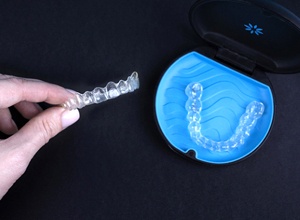 The cost of Invisalign® in Enfield varies from case to case and depends on
a number of factors. We will be happy to provide you with a cost estimate
during your consultation. We will also help you explore your payment
options. We even provide a special Invisalign® offer to get you started on
your treatment!
The cost of Invisalign® in Enfield varies from case to case and depends on
a number of factors. We will be happy to provide you with a cost estimate
during your consultation. We will also help you explore your payment
options. We even provide a special Invisalign® offer to get you started on
your treatment!
Factors that Affect the Cost of Invisalign®
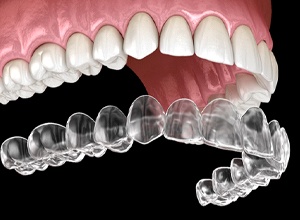
Some factors that usually affect the total cost of Invisalign® include:
- Whether you are straightening one arch of teeth or both. Logically, straightening one arch usually costs less than straightening both.
- The extent and complexity of your dental misalignment. More complex cases often come with a higher price than cases that are primarily cosmetic.
- The nature and number of any extra orthodontic accessories that you may need. For example, some patients require special buttons for their aligners.
- The overall length of your treatment. Longer treatments typically require more aligners and have a higher cost.
- Your compliance with treatment. Losing track of your aligners and forgetting to wear them may increase your total cost.
Invisalign® vs. SmileDirectClub™: Which Is the Better Value?

SmileDirectClub™ and other DIY braces systems usually come with a low price — somewhere in the ballpark of $2,000. Invisalign® typically costs $3,000 - $8,000. Keep in mind, though, that you must consider cost as well as value. With DIY braces, you do not get to enjoy the personal support and supervision of a highly trained dentist. There is a much greater margin for error — if your treatment does not go as planned, it could be very expensive to correct any problems that are caused by it. Additionally, the aligners tend to be made out of basic plastic rather than high-tech materials.
In contrast, Invisalign® uses state-of-the-art technology, employs a patented material for its aligners, and delivers consistently reliable results. Most patients would agree that the peace of mind you enjoy with Invisalign® in Enfield makes it more than worth the price.
Does Dental Insurance Cover Invisalign®?

Some dental insurance policies have a lifetime maximum for orthodontic treatment, including Invisalign®. You will have to check your specific policy to find out if it applies and how much it may reduce your out-of-pocket cost for Invisalign®. Our team will be happy to help you navigate your insurance policy. If you have an HSA or FSA through work, you may be able to use that along with your insurance to pay for your treatment.
Options for Making Invisalign® Affordable

As your Invisalign® dentist in Enfield, we want to help you afford your treatment! In addition to assisting you with insurance, we offer a few provisions that can make it easier to manage the cost of Invisalign®:
- A FREE consultation. You can take the first step on your journey for nothing out of pocket.
- $999 to get started. This is a reduced down payment offer that you can take advantage of if you enroll in autopay and meet other criteria as outlined in your financial agreement.
- Essential Dental Plan. This membership plan provides a discount on most of the services we offer. It is a great option for patients without insurance.
The team at Four Town Dental is ready to help you enjoy all the benefits of Invisalign®. Schedule your consultation today to learn more about the financial aspects of this treatment.
Invisalign® FAQs

The team at Four Town Dental is ready to put our expertise to work to help you enjoy all the advantages of Invisalign® in Enfield. Of course, it is understandable if you want to gather more information before you schedule your consultation. Below, you will find answers to some of the most frequently asked questions about this treatment. If you do not see your specific question addressed, or you would like further explanation on anything you discover here, you are more than welcome to give us a call.
How Long Does Invisalign® Take?
On average, Invisalign® takes about 12 months to finish moving a patient’s teeth. Your case, though, may require more or less time. It depends on things like how many aligners you need, your compliance with treatment, and the specific details of your oral health and dental misalignment. During your consultation, we will be able to provide you with an estimated timeline for how long your treatment will take. In most cases, Invisalign® is several months faster than traditional metal braces.
Does Invisalign® Hurt?
Invisalign® aligners are constructed out of a smooth, patented form of plastic, which is designed to feel as comfortable as possible in the mouth. There are no sharp edges or metal parts to irritate the sensitive soft tissues in your mouth. However, keep in mind that orthodontic treatments work by applying pressure to the teeth. Therefore, a degree of discomfort is to be expected, especially when you switch to a new aligner. You can make your treatment as easy as possible by switching to a new aligner at night, taking pain medication if necessary, and sipping on cold water. If you ever experience any severe pain with Invisalign®, call your cosmetic dentist in Enfield. There might be an issue with your aligners that needs to be fixed.
What Happens After Invisalign®?
After you have gone through all of your Invisalign® aligners, we will verify that the results are what we originally anticipated. Once we are satisfied with the positioning of your teeth, we will provide you with instructions on how to maintain your results. One of the most important things you can do is regularly wear a retainer, a small device that will prevent your teeth from drifting back out of place. At first, you should wear it full-time (20 – 22 hours each day). After a few months, though, you might be able to switch to wearing it only at night.
Can Invisalign® Fix an Overbite?
Invisalign® is able to correct many cases of mild to moderate overbite. It usually does so with the help of additional orthodontic accessories, such as elastics and buttons. If your overbite is too severe for Invisalign® to address, you may need to get traditional braces. Later, it might be possible for you to switch to Invisalign®. During your consultation, we will be able to let you know whether clear aligners are a suitable way to address your specific type and degree of dental misalignment.
